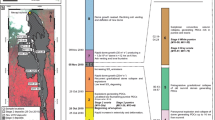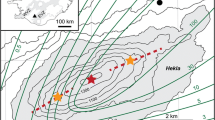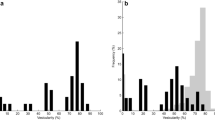Abstract
Dacite tephras produced by the 1991 pre-climactic eruptive sequence at Mt. Pinatubo display extreme heterogeneity in vesicularity, ranging in clast density from 700 to 2580 kg m–3. Observations of the 13 surge-producing blasts that preceded the climactic plinian event include radar-defined estimates of column heights and seismically defined eruptive and intra-eruptive durations. A comparison of the characteristics of erupted material, including microlite textures, chemical compositions, and H2O contents, with eruptive parameters suggests that devolatilization-induced crystallization of the magma occurred to a varying extent prior to at least nine of the explosive events. Although volatile loss progressed to the same approximate level in all of the clasts analyzed (weight percent H2O=1.26-1.73), microlite crystallization was extremely variable (0–22%). We infer that syn-eruptive volatile exsolution from magma in the conduit and intra-eruptive separation of the gas phase was facilitated by the development of permeability within magma residing in the conduit. Correlation of maximum microlite crystallinity with repose interval duration (28–262 min) suggests that crystallization occurred primarily intra-eruptively, in response to the reduction in dissolved H2O content that occurred during the preceding event. Detailed textural characterization, including determination of three-dimensional shapes and crystal size distributions (CSD), was conducted on a subset of clasts in order to determine rates of crystal nucleation and growth using repose interval as the time available for crystallization. Shape and size analysis suggests that crystallization proceeded in response to lessening degrees of feldspar supersaturation as repose interval durations increased. We thus propose that during repose intervals, a plug of highly viscous magma formed due to the collapse of vesicular magma that had exsolved volatiles during the previous explosive event. If plug thickness grew proportionally to the square root of time, and if magma pressurization increased during the eruptive sequence, the frequency of eruptive pulses may have been modulated by degassing of magma within the conduit. Dense clasts in surge deposits probably represent plug material entrained by each subsequent explosive event.
Similar content being viewed by others
Author information
Authors and Affiliations
Additional information
Received: 4 December 1997 / Accepted: 13 September 1998
Rights and permissions
About this article
Cite this article
Hammer, J., Cashman, K., Hoblitt, R. et al. Degassing and microlite crystallization during pre-climactic events of the 1991 eruption of Mt. Pinatubo, Philippines. Bull Volcanol 60, 355–380 (1999). https://doi.org/10.1007/s004450050238
Issue Date:
DOI: https://doi.org/10.1007/s004450050238




